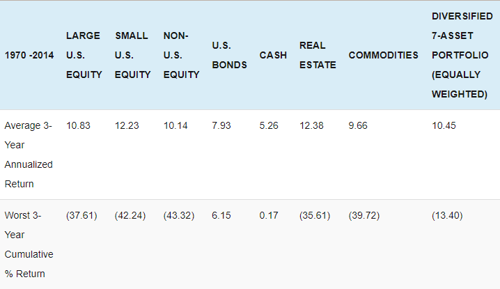September 29, 2015 Perspective
September 29, 2015 Perspective
September 29, 2015 by Lesjak Planning
Most investors would have to agree that staying with a long term, logic-driven investment plan during periods of high volatility is not easy. As recently as 2009 while the markets continued their free fall, those investors that could not take the stress any longer threw in the towel and sold out. Almost immediately, as the last sellers exited, equities began their six year run to record highs. As new highs were being toppled on a regular basis, these same investors jumped back in with expectations of continued growth at the previous frantic pace.
We now find ourselves in another uncomfortable market that has no direction, but plenty of volatility. There are multiple fear inducing issues in the news worldwide that have market pundits calling for another market meltdown. While no one can know what will happen in the short term, past history tells us that when the majority think a market will take a certain direction it most often does the opposite. The numbers tell us that, unlike the rampant optimism of investors prior to the major declines in 2000 and 2008, investor sentiment is very negative now.
Keeping focused on your long term investment goals is imperative during these emotional times. For example, the chart below details the Average Annualized 3 year return over the past 45 years for each of the investment sectors. Statistics reveal that these returns can only be achieved, though, if you stay invested. The second performance chart category shows the worst cumulative return over 3 years in the last 45 years. Would it be possible to achieve the average 3 year returns if market declines caused an investor to cash out during that decline? The numbers say no.
The recent three year average annualized return of the S & P 500 Index through December 2014 was over 20%. Since the average 3 year return over a long time period is nearly 10.8%, should we expect some sort of decline in the S & P 500 to bring the average down to its historical norm? The 11% decline in August probably answered that question. In another investment sector, the Commodities Index, the average return over the past 3 years was a negative 12.8%! Since again, the average return for that Index over time is almost 10% annually, should we expect above average returns years to come? Probably, but we cannot know exactly when. We can play this up and down versus average scenario for each and every investment sector and come to the same result.
Those that are taking withdrawals from accounts should have enough in cash and fixed income to get through this volatility, while those that are investing regularly are benefitting by purchasing more shares at lower prices.
Remain focused on your goals and tune out the emotional volatility.
Performance metrics for seven core asset classes and a diversified portfolio over the past 45 years.
 **Chart Disclaimer**
**Chart Disclaimer**
Past results are no guarantee of future performance. Stated figures are for illustrative purposes only. Source: Lipper
Unless we know for sure when individual markets will peak and when they will bottom, picking well diversified sectors and allocating between them to meet your individual growth needs is expected to deliver good, average results over time.
Markets become volatile at their peaks and valleys because most investors cannot keep focused on their long term goals and fall victim to the emotions that lead to bad decisions. Charles Munger, the famed co-manager of Berkshire Hathaway with Warren Buffett is quoted to have said regarding investing: “It’s not supposed to be easy. Anyone who finds it easy is stupid.”
We continue to look at market fundamentals and the state of both our economic activity and the activity of the major players in the world. Along with the analysts we regularly confer with, we contend that while the current volatility and uncertainty may continue for a few more weeks, the longer term picture looks quite favorable for the equity markets both here and abroad.












































About the author
Lesjak Planning